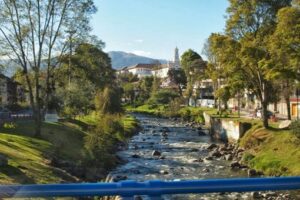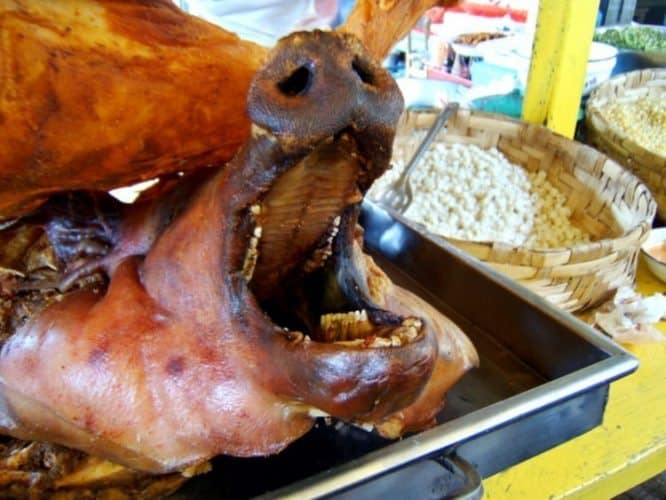
Crafts, Cockfights, and Cranky Animal Snouts Abound in the Andean City of Otavalo
By Darrin DuFord
Throughout rural Latin America, I have grown accustomed to navigating by sight — using landmarks — since street signs are usually viewed as needless luxuries. The Andean town of Otavalo, Ecuador, encouraged a new approach, however: it was the first place that allowed me to navigate by sound.
I first heard a trickle of fearful shrieks bouncing down the street. Then a savage grunt. I found this unsettling but reassuring. The auditory beacons assured me that I was walking in the right direction to reach Otavalo’s early morning animal market, just off the Pan-American Highway.
At least the field near the highway was where the weekly market was supposed to take place. Convincing various hoofed animals weighing more than their owners to enter the field was a different matter.
Cows parked their six hundred pounds on the highway and mooed in protest. Hairy pigs wailed with anxiety as they were dragged toward the gate.
Hoofs don’t score much traction on pavement, but one pig managed to hunker down on an incline, which only earned him a kick in his ham to drive him along.
“Siga, siga” — “Keep moving, keep moving” — barked a lone policeman as he snapped his arms in unheeded calisthenics, a ghost in a pretty uniform. Because of such livestock gridlock, some of the transactions shamelessly went down along the highway instead of in the field, and saved the buyers the 50-cent tax on all purchases.
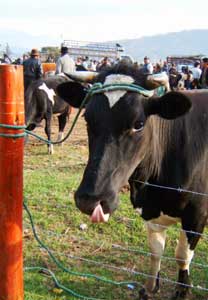
The Woodstock in Vegetarian Hell
I joined the rest of the creatures, edging toward the gate, their heads bobbing downward, as we entered the narrows of the entrance. Being part of such a slow tide congregating towards an open field, I felt the odd sensation that I was part of a Woodstock-like gathering. The Woodstock in Vegetarian Hell, perhaps.
As more than a hundred animals from several genuses waited in a cramped formation, a twanging tension circulated around the grounds. Tension seemed to toy with the edge of chaos, panic, or rebellion.
Bulging cow eyes attempted to size up the morning as tongues licked quivering stalactites of drool off snouts. Every groan and bovine emanation seemed to ratchet up the confusion. Was that last cry the cue for the subjugated to band together and fight their captors? Or was it simply another wry commentary?
Those were a few thoughts that burbled about when I considered that collectively, the animals easily outweighed their human handlers.
I glanced through the crisp morning air at the valley framed by the barren mounds of the Andes. Below, a sea of farmers grasped ropes that secured their bounty. Buyers circled. The shoppers’ feet — some wearing shoes, others not — indifferently churned a mixture of lamb, cow, and pig manure into the grounds. Its pungency was only held in check by the briskness of the early hour.

While the buyers fertilized the field, what did they look for in a prospective animal?I asked a squinting villager, who was in search of a pig, what his criteria were.
“The fat ones,” he insisted.
The field offered all kinds of porcine permutations: young, old, hairy, extra hairy, and, of course, fat. Feel free to mix and match.
Breaking the curse of serfdom
The market was not a show for tourists, however. After all, cows don’t tend to be easily transportable souvenirs. The gathering wasn’t part of a new trend either: the Otavalo region has been holding livestock markets for more than 100 years. The market’s location is no coincidence either, because the region claims history of commerce, especially in textiles, that predates the Incas.
Ironically, the Otavalans’ very skills would lead to their hardship for centuries. When the Incans arrived in the late 1400s and recognized the ability of the area’s weavers and itinerant merchants, the Incans rewarded said talent by quickly subjugating the weavers into labor obligations.

Never one to miss an opportunity to exploit indigenous labor, the Spanish Empire slaughtered its way up the Andes and became the Otavalans’ new bosses fifty years later. To ensure each indigenous weaver produced his or her quota of work for the Spanish crown, the Otavalans’ new lords chained many of the weavers to the looms.
Worker’s Uprising
Despite a worker’s uprising in 1777 during which the indigenous sacked haciendas and gleefully wasted a few crooked clerics, the perpetual serfdom continued — even after Ecuador gained independence. The recipient of labor obligations simply shifted from the ousted Crown to the powerful oligarchy. Indigenous labor obligations were only abolished in 1857, two years after Ecuador abolished black slavery.
But the oligarchy ended up owning most of the valley, so they kept exploiting their workers. Business as usual. In 1964, however, Ecuador, fearing a communist revolution, passed the Law of Agrarian Reform, which smashed up large landholdings and finally enabled the indigenous of the area to own land that they worked.

It didn’t take long for indigenous Otavalans to combine their land ownership with the skills the Otavalans have maintained throughout the generations, creating a rarity in the Western world: a prosperous indigenous community. Today, Otavalo, a town whose province of Imbabura is 70 percent indigenous, even has an indigenous mayor.
A grid of colorful fabric
And speaking of prosperity, when I crossed town, I became entangled in the second of Otavalo’s markets: the crafts bazaar, showcasing the area’s ever-evolving weaving skills. Originating from the Plaza de Ponchos in the town’s center, the crafts market appears every day, but on Saturday, it spirals out onto the streets of Otavalo, forming a grid of colorful fabric, ceramics, and weaved hats.
Rows of imitation shrunken heads, emulating the now-retired practice of the Shuar, one of Ecuador’s Amazonian tribes, awaited modern-day trophy collectors. While breastfeeding Otavalo’s newest generation, scarf vendors in ornate blouses simultaneously haggled with tourists from North America, Europe, neighboring Colombia, and even Quito.
The Otavalans were continuing their pre-Incan tradition of creating goods for faraway buyers, although materials, image motifs, and technology have adapted along the way. Anybody want to buy a hand-sewn Castro doll?

Fur and feathers
The crafts market merely remains a meatless eye in a vortex of carnivorous lust, for at the other end of town, the elbow-to-beak crowd of the small animal market, the place to buy and sell fowl and other critters that can fit in your hands, was already in a full whirl when I approached.
Fur and feathers eddied above the haggles. Crammed onto the confines of a narrow side street, the market swallowed me up as I entered, spitting me out next to a vendor holding a burlap bag filled with guinea pigs. She held one up by the back of its neck to show the shoppers the goods.
“Cuyes, Cuyes,” she yelled. Guinea pigs, guinea pigs. “Two dollars for a small, three-fifty for a large,” she yelled. “A large feeds two people.”
It was all about the grip. Next to me, a guinea pig squirmed free from another vendor and hastened its valiant escape attempt. The animal bounced off the road and spun its claws — like in the cartoons, I’m pretty certain — but since the thicket of shoppers formed such a dense bulwark, the guinea pig didn’t get very far before it was scooped up and returned to its canvas purgatory.
“Siga, siga,” another uniformed ghost sighed from somewhere.
I passed pens jammed with turkeys, ducks, and chickens — all three participants in a turducken, that Cajun monstrosity of meat. The birds couldn’t have possibly stood any closer together without actually becoming said dish (minus the Cajun cornbread stuffing).

Keeping a couple of roosters from fleeing required other techniques, namely tying the two of them together. Since roosters don’t care much for each other’s company, this arrangement must have been uncomfortable for the fellows. But that didn’t stop them from attempting a semi-concerted effort to flap away from the top of the box they had been placed upon. Because of their awkward, twined-up aerodynamics, however, they only succeeded in falling off the box together.
The twine technique proved popular for whatever animals were for sale. If a vendor was selling a chicken and a kitten, he tied them together. Rabbits found themselves bound to roosters. The only pattern seemed to be that a vendor would only tie animals together that are of roughly the same size and weight.
In case you are curious, the kittens, like the puppies, were sold as pets. If you’re still in doubt, I passed a man indulging his morning’s purchase, a furry little puppy, in a gentle embrace. He crooned in a falsetto voice, normally reserved for talking to infants, as he smothered the puppy with terms of endearment ending in the Spanish diminutive ending “-ito,” not exactly how someone would normally treat a future flank steak. The guinea pigs, however, left the market in canvas bags.
Surfing the wave of meat
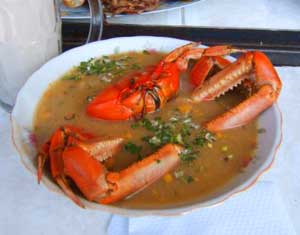
As for most of the other chirping and squeaking purchases, I found their logical endgame at the Otavalo food market, the fourth and final piece to Otavalo’s Saturday morning buzz.
Abutting the southern flank of the crafts vendors, a piecemeal roof invited me into alleys of stalls, some stacked with sacks of spices, others displaying tire-sized chunks of lard. Knuckles of some hoofed animal burbled in oil, and arroz con pollo (rice with chicken) bounced around in hot frying pans.
Each stall claimed its own specialty, including one that served crab. The Otavalans, like successful people everywhere, desire gastronomic variety, and have acquired a taste for some dishes not cultivatable locally, in this case, shellfish that is shipped up from the coast.
Feeding this passion, men in dress shirts wander the streets of the valley and sell live, flailing crabs — a refreshing switch from the expected haul of bootleg DVDs.
Cracking Crabs with a Hammer
I wanted to test this curious culinary diversity, along with my girlfriend, who earlier, had elected to pass on the animal markets. Pacing ourselves on the deluge of Ecuador’s meat-heavy cuisine, we gravitated toward the crab stall. The stall proved popular — there were no open seats — but a cook at a stall next door offered to fetch us her neighbor’s crab soup (complete with a whole crab bathing inside).
Forget nutcrackers—we were given fat wooden mallets. We just closed our eyes and hammered away at our sweet $3 find.
Clams also regularly find themselves way above high tide — 8,300 feet above sea level, to be exact — in a wok pan at yet another stall at the food market. We grabbed front row seats as my girlfriend asked the dexterous cook and owner of the stall, Lionel, what was in his clam stir-fry.
“Everything,” he answered through a beckoning smirk. He was festooned with a lineup of seemingly incongruous shaker jars and raw shellfish. Would he actually attempt to mix them together? One of his hands tossed in the freshly shucked clams, another spooned in scoops of mustard and some other undisclosed spice, while his third and fourth arms — just blurs of sweat and skin — sprinkled in achiote seasoning and threw in shrimp. How did rice get in the pan already? Ah, the ol’ sleight of hand.

U-pay, U-peel
Make no mistake: Otavalo is a proving ground for anyone who claims to be a carnivore. This reality is flaunted by the most popular item for lunch at the food market: roast pig. The whole thing. Some carcasses held cobs of choclo (Andean large-kernel corn) in their mouths, while others just grinned at their embarrassingly low position in the food chain.
Next to each carcass, I’d invariably find a diner pulling off chunks of crispy, oily skin from the pig head as if she were peeling a giant grapefruit. How does this self-service work, you ask? Pay just a dollar for your order of meat and you earn the right to peel off a piece of skin from the pig head. Go ahead, dig your fingers right in. You paid for it!
What’s that music?
In the afternoon, Otavalo’s meat fest finally went on a well-deserved hiatus, allowing us time to explore the delightfully clean little town. Tourists tend to label the town as nothing special to look at, because there are few traditionally photogenic buildings.
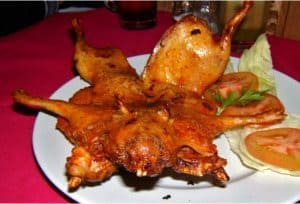
And since the gargantuan crafts market tends to be the singular attraction for most visitors, many may not have noticed that the enterprising Otavalans have proudly invested in the construction and appearance of their city.
Red, blue and yellow squares of masonry — the three colors of the Ecuadorian flag — form the sidewalks. Multi-paneled, varnished wooden doors are all the rage. Ornate lampposts create downtown scenes reminiscent of small-town America. One of the main thruways even has a bike lane.
But the most interesting quality of life enhancements is the town’s garbage trucks. That’s right, garbage trucks. They’re the vehicles whose mechanical guts earn them universal derision elsewhere for not having evolved past the first few earsplitting grinds of the industrial age.
While garbage and recycling trucks regularly prowl Otavalo to keep the town looking its best, the trucks also place something back on the curb — they tinkle out gentle, pentatonic melodies to keep the town sounding its best too. It’s as if each truck’s innards hid a dual-use, spinning music box, plinking one chiming note at a time while secretly crushing bottles. I wanted to litter just so one of the trucks would swoop by and play me a tune.

Making us work for our meal
I would soon procure an honest fix of music at the restaurant Mi Otavalito, where a band squeezed in between tables and swayed to their renditions of Andean folk music.
The music — carried by flutes, guitars, vocals, and a large side drum — sounded awfully familiar to me. That is because for the past few decades, Otavalan bands have been traveling outside Ecuador and performing on city sidewalks from New York to Amsterdam. Live bands comprise yet another of Otavalo’s “commodities” for worldwide export.
But we didn’t go to the restaurant just for its musical ambiance. Remember all those guinea pigs sold at the small animal market? We had a dinner date with one of them. He arrived a little after we did, and was dressed in the most typical fashion: a coat of oven-roasted spices. With his tiny joints and thick skin, he made us work for our meal. If you’ve never eaten cuy, may I recommend that you ask for extra napkins?
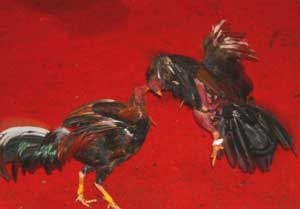
Place your bets
Faces wiped and bellies protruding, we rolled into the town’s nightlife. No more markets, no more meals. No more animals, right? Well, for some, the night is just beginning. You see, in Otavalo, Saturday night is cockfight night.
As with the town’s business acumen and its architecture, Otavalo takes its cockfighting seriously. They built an entire palace devoted to the sport, complete with stadium seating, a roof, and storage cages for the fighters of the evening.
According to the betting board, hundreds of dollars in wagers awaited the outcome of multiple rounds of male angst.
The ring itself, lined with a thin red rug to lessen the visible traces of past skirmishes, is about 18 feet in diameter, but clearly, there’s only enough room for one cock. To ensure entertainment for the $1 price of admission, the rooster handlers taped two-inch, metal spikes to the ankles of each fighter.
When the evening’s announcer stepped into the ring, the gathering hushed, save the intermittent squawking of roosters locked up in cages in the back of the ring. Each of the two first-round handlers shoved his rooster into the other rooster’s face to get the anger flowing.
And then they were released. Neck feathers flared wide like inflatable pool toys. As the handlers crouched down inside the ring and forcefully whispered commands to their fighters, the destruction began.
The ring swirled with the damp scent of a chicken coop. Feathers flew in the air like curse-filled word balloons. Hearing and smelling the excitement below, the caged roosters worked themselves up into a crescendo of a screeching, a chant-like ritual.
There seemed to be only two rules. The first: if the claws of one rooster become snagged in the feathers of another, the handlers would untangle them. And the second: the fight would only stop if either the 20-minute buzzer went off, or a fatality was racked up.
In the first round that night, the buzzer sent both roosters from the ring bloody but lucid. The second round, however, rewarded the crowd with a gladiator-style kill. Without the gladiator-ring cheers. The gathering fell into a funeral-parlor silence.
It was unclear how the handler of the deceased rooster planned to honor him. But I’m sure the town’s food market had a few ideas.
 Darrin DuFord is the author of the book Is There a Hole in the Boat?Tales of Travel in Panama without a Car, chosen as a finalist for ForeWord Magazine’s Book of the Year Awards. A past contributor to GoNOMAD, DuFord’s travel articles have also appeared in Transitions Abroad, Perceptive Travel, and Iguana. Find his latest articles and recipes on his website, Omnivorous Traveler.
Darrin DuFord is the author of the book Is There a Hole in the Boat?Tales of Travel in Panama without a Car, chosen as a finalist for ForeWord Magazine’s Book of the Year Awards. A past contributor to GoNOMAD, DuFord’s travel articles have also appeared in Transitions Abroad, Perceptive Travel, and Iguana. Find his latest articles and recipes on his website, Omnivorous Traveler.
- These 9 U.S. National Parks Require Reservations in 2024 - April 17, 2024
- Take a Hike in Olympic National Park - April 17, 2024
- The Wild Mississippi: 2340 Miles Across Ten States - April 8, 2024


